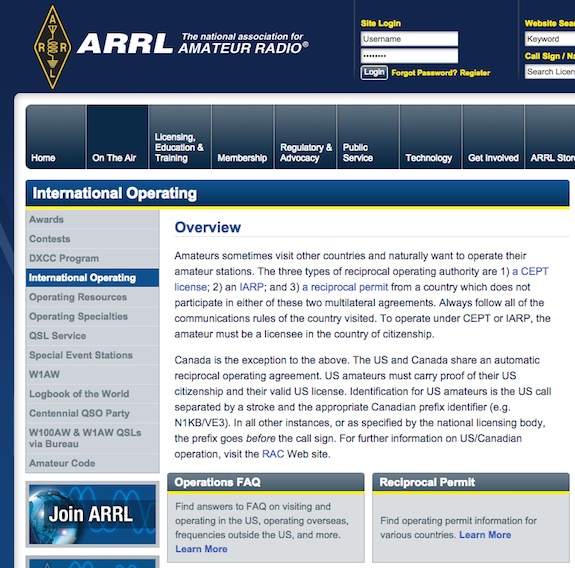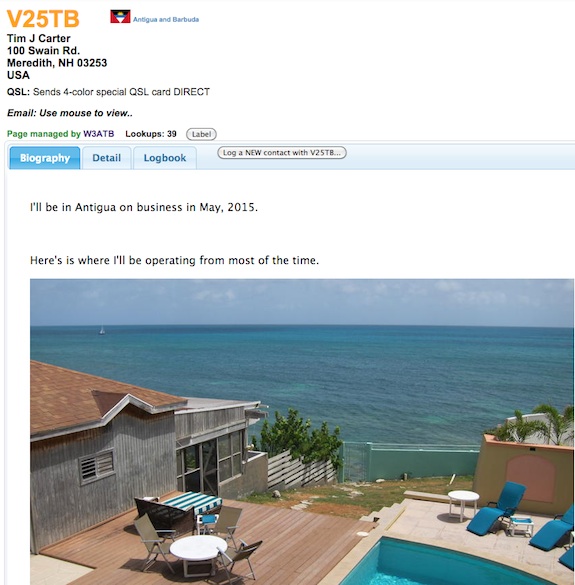Yesterday I had a chance to test my determination to avoid a QSO skunk and to eat at least one third of two bags of potato chips I purchased for a special outing with an icon and a titan in QRP (low power) outdoor radio. I was headed to the trailhead of the paths that lead to the top Mt. Kearsarge in Winslow State Park in central New Hampshire.
Joining me on the outing were Jim Cluett – W1PID and Dave Benson – K1SWL. Jim is regarded by many on the East Coast as one of the titans of outdoor low-powered radio. Dave is an icon in QRP radio as he’s the founder of Small Wonders Lab from which the infamous Rockmite QRP radio was borne.
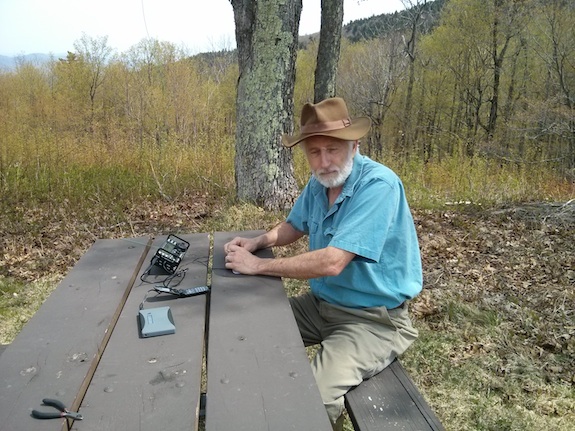
Here’s Dave Benson – K1SWL. I caught him with his eyes closed, he’s not sleeping though. He’s busy adding another entry to his massive log. Photo credit: Tim Carter – W3ATB
With abnormal high temperatures over the past week, the devil black flies were swarming like Christmas shoppers on Thanksgiving afternoon. We were about to find out who would win the battle as a less-determined operator would skitter from the stunning overlook skunked with no contacts or QSOs.
The other problem I faced was making sure all the sour cream and onion and barbecue potato chips didn’t disappear down the gullet of W1PID. He eats those flavored wafers faster than a tree chipper gobbles up limbs from cut trees. He almost always reciprocates with copious amounts of ice cream, so it’s a very fair exchange.
The day started cool with the temperatures in the upper 50’s F, but soon the sun peppered us with a strong combination of ultraviolet and infrared rays. That solar heating of the ground generated a much-needed breeze at the overlook providing a natural fan helping to blow many, but not all, of the biting black flies away.
Just north of the parking lot at the end of the road in Winslow State Park is a flat area with a new covered post and beam shelter. In the grass there were fire pits created by giant slabs of native granite honed by the continental glaciers that cut their way from the North Pole down to Cape Cod just 15,000 years ago.
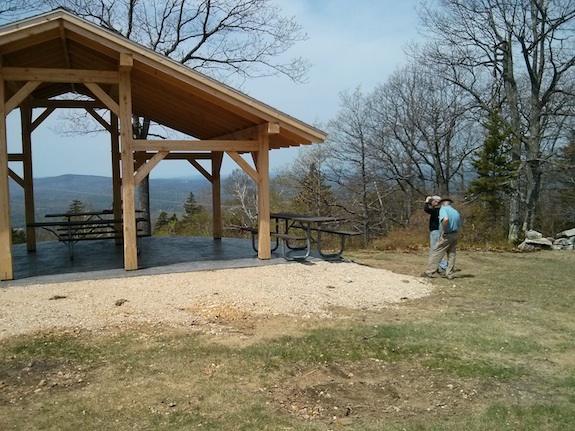
Here’s the stunning shelter with Jim and Dave discussing Jim’s L-shaped antenna. Photo credit: Tim Carter – W3ATB
Seven or so nice picnic tables in the grass provided excellent places to set up our equipment. Thirty and forty-foot trees were on the edges of the grassy area whose many branches would provide ample support for our thin wire antennas.
I was dying to test a new resonant 30-meter dipole antenna I had made the previous weekend. With a little effort I was able to get it up about 30 feet in the air with the RG-174 coax cable dropping straight down onto a picnic table. Jim used his Elecraft KX3 to determine the SWR. He said it was nearly perfect.
Midday 30 meters can be a pretty dead band. I did hear one or two very strong stations, but they were involved in extended conversations and I couldn’t break in.
Dave and Jim set up at different tables with Jim taking the best spot under the handsome post and beam shelter with a commanding view to the west. Just a few miles away, Mt. Sunapee had a few dangling white ribbons of snow left on her many ski runs.
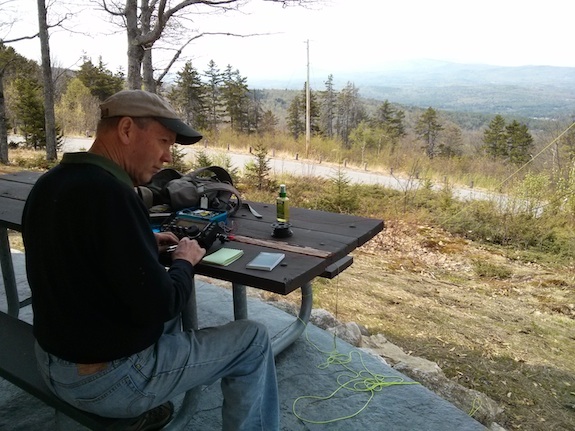
Jim Cluett – W1PID is busy grabbing one of his many QSOs with Mt. Sunapee off in the haze. The photo makes it look much more hazy than it was. Note the bottle of black fly spray on the table and the potato chip flakes on the ground. Photo credit: Tim Carter – W3ATB
Soon the air was filled with dits and dahs from their matching KX3 radios. I intend to buy one as a reward for myself once I master Morse code at 18 or more words per minute.
I was using my trusty HB-1B quad-band radio. It’s a workhorse of an outdoor portable radio and it makes for a great beginner radio for anyone wanting to do QRP radio. If you’re thinking of buying one, I suggest you wait. The manufacturer is introducing a new model with five HF bands that tend to be more active in daylight hours.
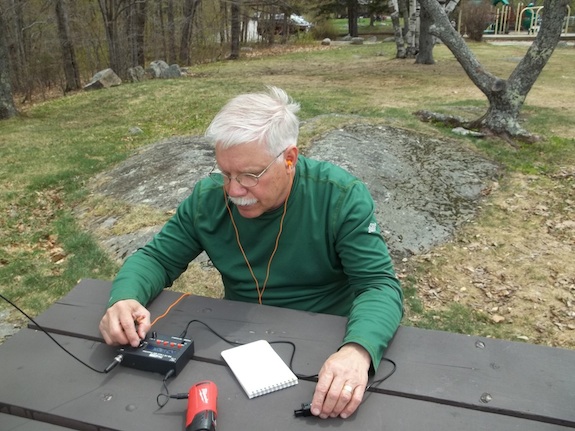
Here I am with my trusty HB-1B working 20 meters. Photo credit: Dave Benson – K1SWL
Jim and Dave are highly skilled Morse operators. They both have been hearing code for no less than 50 years apiece. I’ve only been a serious student of CW for a little over one year and have finally achieved a moderate level of skill. I can hear Morse sent with correct character spacing at about 12 WPM.
It was a Saturday and multiple contests were in progress. This made it as easy for Dave and Jim to make fast contacts as it was for the black flies to bite me on my legs, arms and the bald spots of my head.
I believe Jim got about a dozen contacts in less than 30 minutes and Dave had to have about ten. I spent half my time trying to work the desolate 30 meters, and was fast approaching a skunk.
“Take down that dipole and put up your par EndFedz antenna as a horizontal using the same halyards,” said Jim.
“But you’ve always told me a vertical orientation was the best,” I replied more than slightly confused.
Dave was hovering taking in the back and forth banter.
“Listen. Your multi-band dipole back home works great, right? Didn’t you just do your first Australian contact with a horizontal antenna earlier this week?”
(GRINDING NOISE)
The gears in my head were meshing. DUH!
Of course the par EndFedz would work as a horizontal. I was lucky that in just minutes I could get it up about 30 feet off the ground employing the same multicord halyards that were stretching the 30-meter dipole taut.
The par EndFedz is a pre-tuned antenna good for 10, 20 and 40 meters supporting up to 25 watts of transmit power.
As soon as I connected it to my HB-1B I was in the center of the jungle. There were strong signals and QSOs happening everywhere on the 20-meter band.
Within twenty minutes I had three Qs!
NEVER before had I gotten three QSOs on an outing. It was a new first for me. Most of that was due to it being a contesting day as there were just more operators to choose from. I don’t attribute much to my poor skills.
As we packed up to leave, I noticed that 95% of the potato chips were gone. I don’t think that Dave and I ate 66 percent of them, but it didn’t matter. I was basking in the glory of my three contacts and being in the company of two of the top QRP radio operators in New England.
Not even the devil black flies could ruin my day, even though they gave it their best shot.
I hope I’m blessed to do more outings with Dave and Jim. It’s humbling to be in their company. Next time I’ll get three bags of chips.

